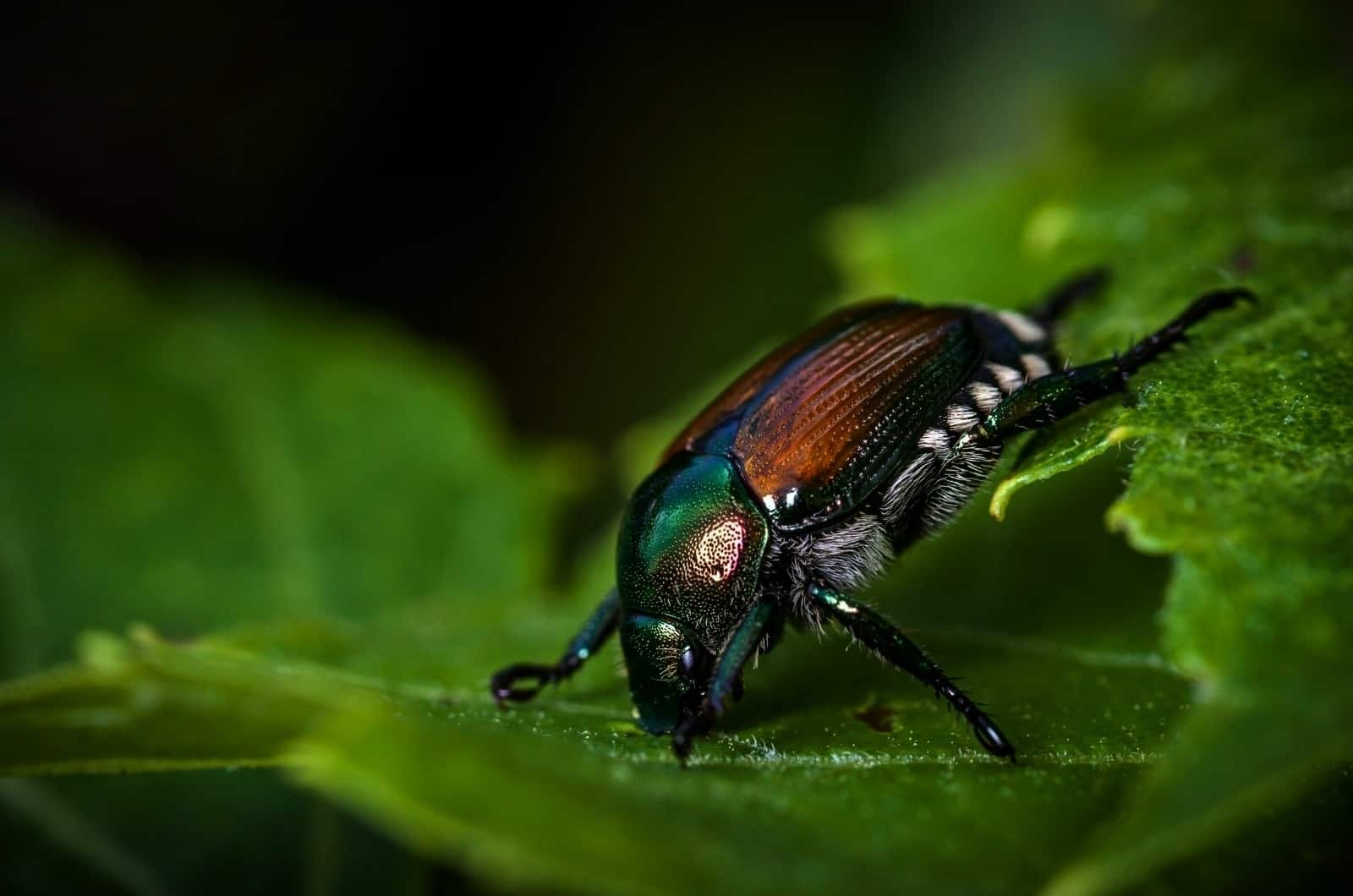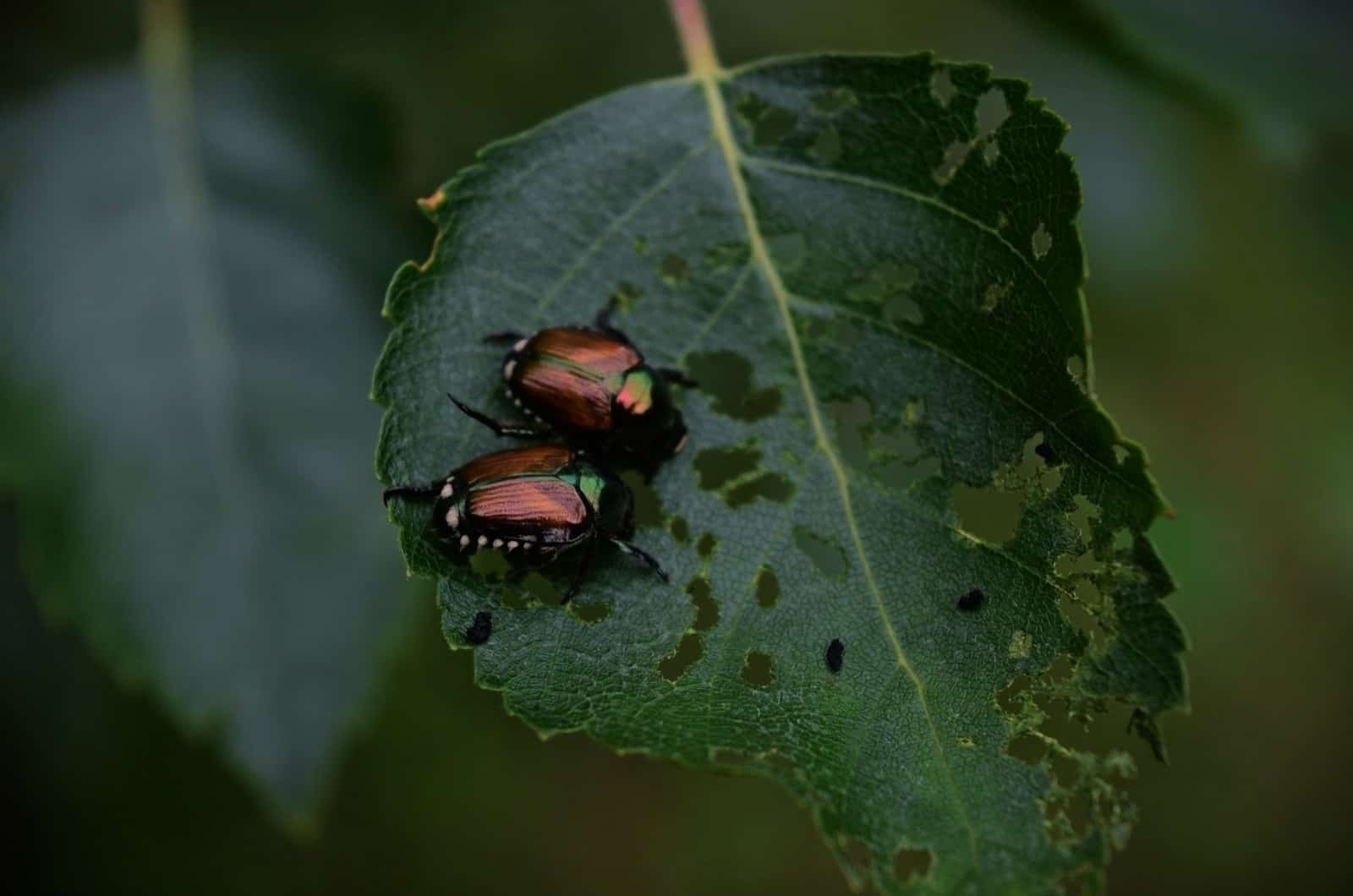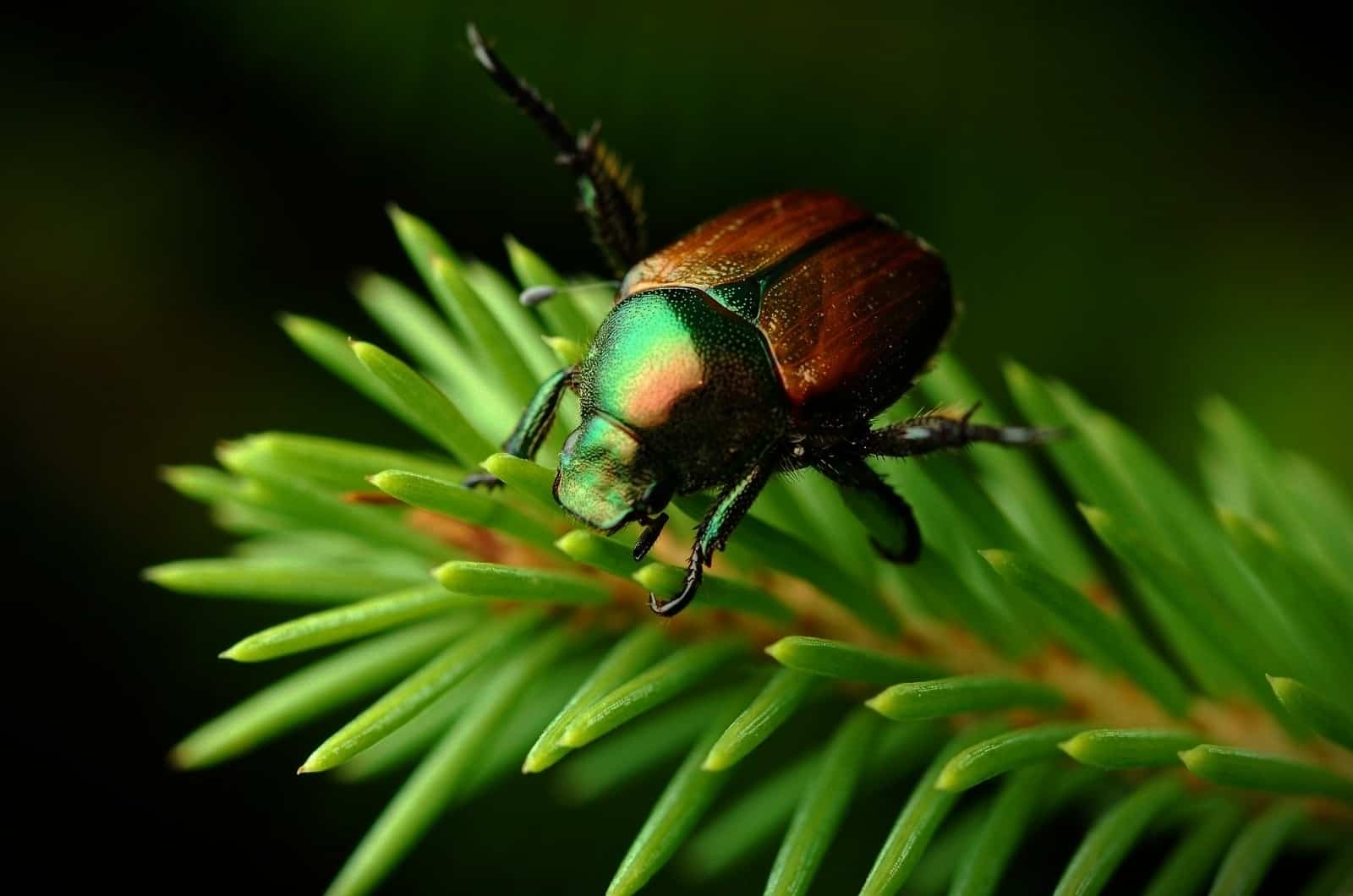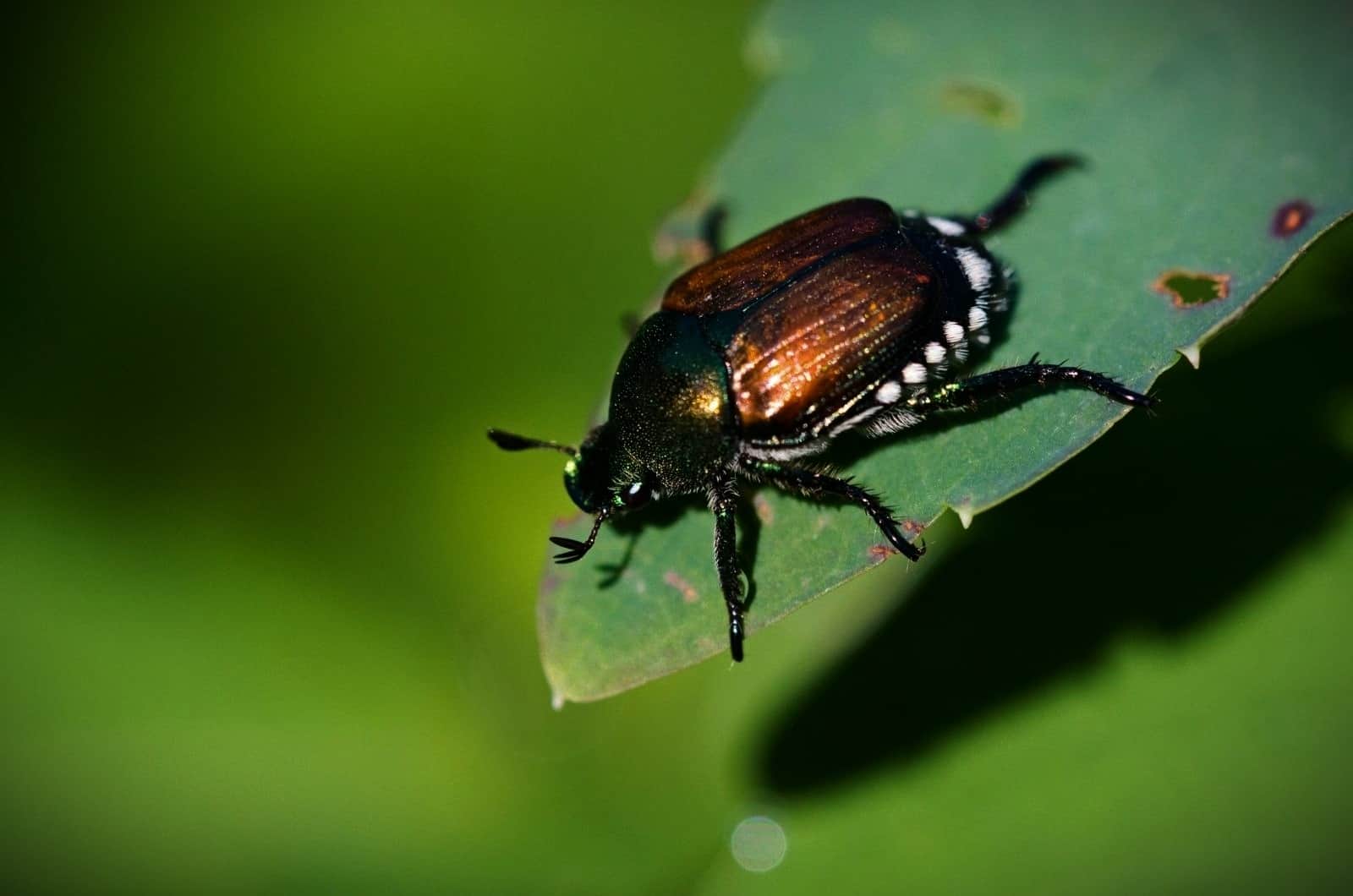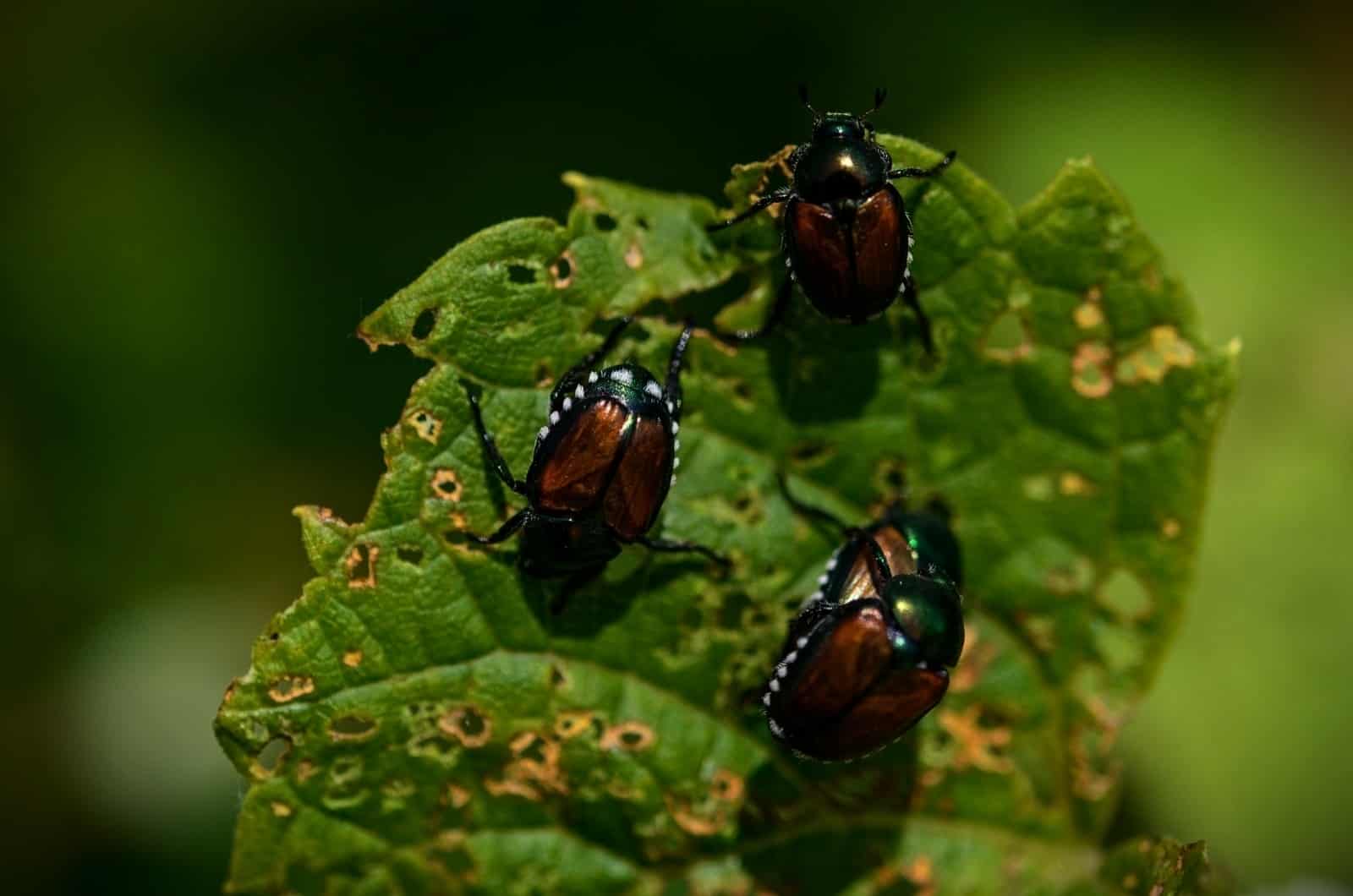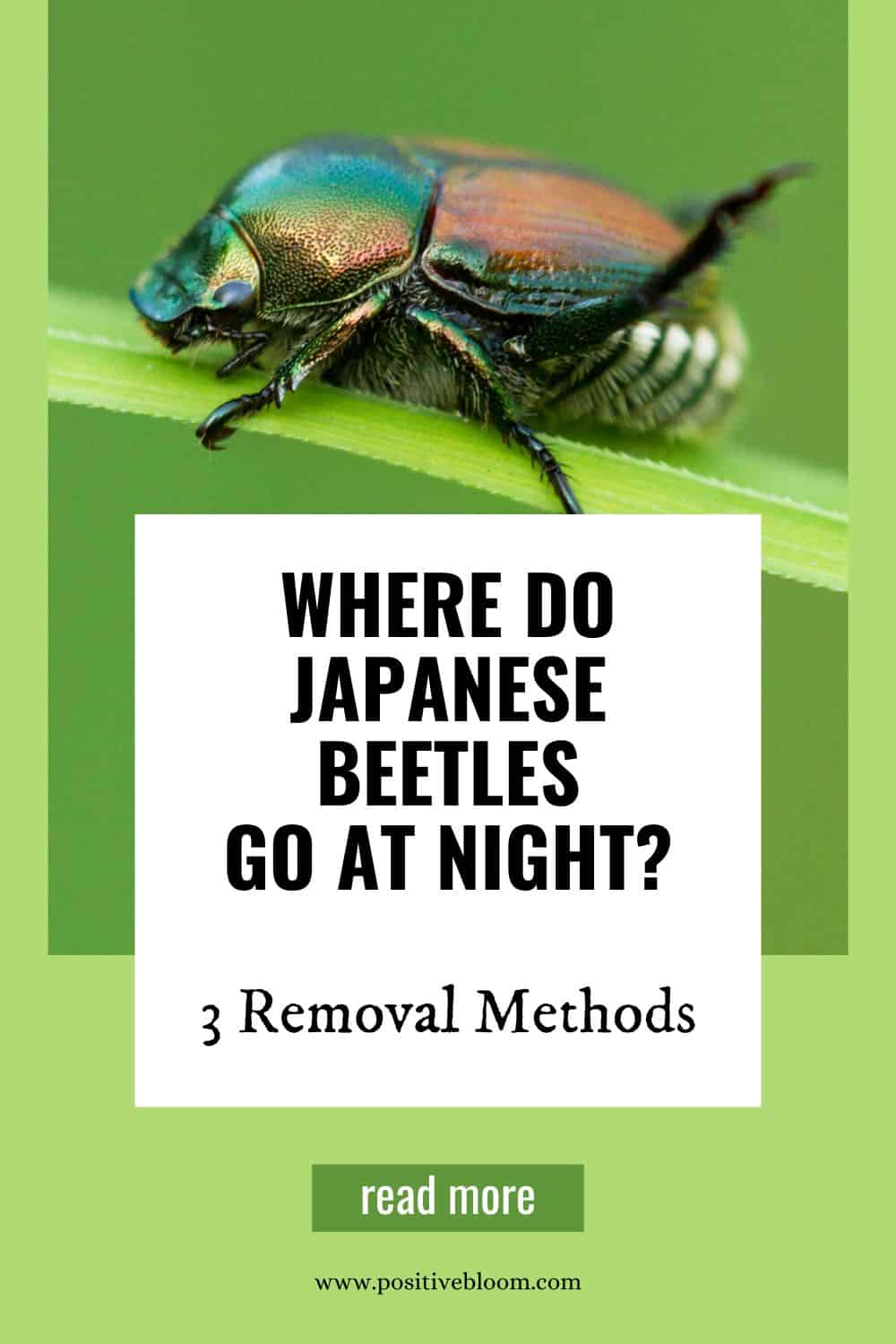Positive Bloom is an Amazon Associate and we earn from qualifying purchases through these links at no extra cost to you.
A Japanese beetle infestation is something all gardeners will have to face at some point, whether they make holes in lawns or nibble on trees and veggies.
This invasive species can quickly overcome your entire garden during the day and then “hide” when the sun sets.
But where do Japanese beetles go at night? And why do they disappear?
These are the questions we’ll deal with in the following article, alongside other important information, such as when they are active, what weather conditions they like, and how to get rid of them.
We’ll even discuss the life cycle of these bugs from Japan so that you can understand them better and remove them more effectively.
Where Do Japanese Beetles Go At Night?
Japanese beetles enter their shallow nests in the ground as the night approaches. They usually make these shelters a couple of inches below the surface and near dense leaves, so if you have lots of vegetation, it’s a good chance these bugs will hide there.
Japanese beetles aren’t active at night, although you may notice some adults around your yard toward sunrise or sunset.
Therefore, if you notice small holes in the grass made overnight, one of the reasons could be that you have some Japanese beetles in the ground!
When Are Japanese Beetles Active?
Japanese beetles usually work and destroy your plants during the day and in warmer seasons, particularly in the summer. This summer species loves warm days and cannot survive the cold.
If you notice some bugs feeding on your plants at night during the summertime, it’s probably not a Japanese beetle, but northern masked chafers, which are nocturnal pests.
Activity Of Japanese Beetles During The Day
Japanese beetles are diurnal insects (active during the daytime), so they’re usually busy during the day from 9 am to 3 pm.
Of course, you might notice a couple of bugs earlier or later in the day, but that’s when they either wake up and wreak havoc in your garden or go to sleep.
What Season Are Japanese Beetles Most Active?
These pests are most active during warm seasons from late spring and well into the summer (from mid-June to mid-August), so gardeners frequently call them summer bugs.
Furthermore, Japanese beetles only last about two months and usually die before the temperatures drop.
But if some do manage to stay alive as the first frost approaches, they’ll look for good nesting locations and protective foliage to hide and survive the harsh winter conditions.
Weather Conditions That Japanese Beetles Like
Japanese beetles love warm days and will thrive at 85-95 degrees Fahrenheit. Generally speaking, the hotter the conditions, the more active they’ll be. This is also one of the reasons why water bugs come out in summer.
Even though they like heat, they will leave their underground nests as soon as the temperatures reach 70 degrees Fahrenheit and above.
Japanese beetles also love humidity and will be more active once it rises above 60%. High air moisture prevents these pests from flying, so they must eat to pass their time.
What Happens To Japanese Beetles In Winter?
We mentioned how these beetles are more active during brighter hours in warm and humid conditions, but what happens to them in winter?
As the temperatures drop below 70 degrees Fahrenheit, Japanese beetles die. However, some can survive as larvae in their beetle nests hidden underground and in thick foliage, which keeps them warm enough.
Adult Japanese beetles usually survive for about two months, but if some do manage to last until the first frost hits, they will look for these underground nests to reproduce and try and survive the cold.
The Life Cycle Of Japanese Beetles
The four phases of Japanese beetle growth are egg, larva, pupa, and adult beetle. Understanding these stages can help you effectively deal with the infestation, mainly because the first three phases take place underground.
But let’s first learn some basic info about these pests. In etymology and gardening, they’re known as Popillia japonica and are a type of scarab beetle found in America (USA and Canada), Europe, Asia, and some parts of Africa.
Their lifespan is usually around two months, so this beetle species will likely die before the summer ends. However, they will try to mate before the warm days are over and lay eggs, which have a greater chance of overwintering.
Egg
The first phase of Japanese beetle growth is the egg. The female Japanese beetle leaves the plant it’s feeding on and creates an underground beetle nest where it lays 1-5 oval, white eggs.
The moisture from the soil will support the growth of eggs, and the female beetle will get back to munching as quickly as she can.
This process of laying eggs will repeat throughout the season until the female lays around 40 eggs.
Larva
The eggs grow and turn into Japanese beetle larvae, which can overwinter in their nests if the temperatures outside are low.
Japanese beetle grubs (larvae) feed on turfgrass and plant roots. They are usually white and pass through five different developmental stages (instars) before they turn into pupae.
As the larvae mature, they look for more food sources and move into the ground, creating more damage to your plant roots.
Pupa
Once the grubs completely develop, they pupate and turn into adult beetles. The pupae are usually cream or red-brown and no wider than half an inch.
When adult Japanese beetles are fully developed, they enter the outer world and start feeding on plants.
Adult Japanese Beetles
At this stage, beetles start to release pheromones that attract others. They all feed together, reproduce, lay eggs in the soil, and repeat the process until they die or the frost kills them.
How To Get Rid Of Japanese Beetles
There are many ways to exterminate Japanese beetles from your garden, including using trap crops, natural predators, insecticides and pesticides, beneficial nematodes, etc.
However, in North America, and particularly in the East and Mid-west, these bugs don’t have any predators, so you might want to consider some other ways of removing them.
Finally, you should adjust watering since these bugs thrive in humid environments. Therefore, understanding the best and the worst time to irrigate plants is crucial.
Watering your plants at night will hurt them and raise the humidity levels, which increases the risks of fungal diseases and attracts Japanese beetles.
Remove Them By Hand
Removing the beetles by hand may seem tiresome, but it is one of the most effective ways to get rid of Japanese beetles.
Simply pick them off the plant and drop them in a bucket of soapy water.
Set Up Japanese Beetle Traps
Many growers advise using Japanese beetle traps to deal with infestations, but sometimes they do more harm than good.
These traps contain a scent that attracts Japanese beetles, and the pests will follow it. They’ll then feed on the nearby plants, so make sure to place them away from your garden.
Most of the time, the beetles won’t enter the trap, but will feed on the plant life around it instead.
Still, if you do want to try it out, here’s a product just for you:
Use Repellent Plants
Some of the best trap crops for Japanese beetles are geraniums. These flowers lure insects and paralyze them. Of course, you will have to sacrifice some of them, but at least you’ll reduce the infestation.
Once the bugs are helpless, they are easy prey to birds. You can also remove them yourself by picking them and dropping them in soapy water.
You can try out some repellent plants, such as catnip, marigolds, rue, and tansy, whose fragrance and chemicals deter Japanese beetles.
Introduce Natural Predators
The natural predators of these beetles are tachinid flies and parasitic nematodes. These species will keep the infestation under control, so you won’t have to deal with the invasion.
These beneficial nematodes are excellent at fighting Japanese beetle infestations:
You can also try using milk spore fungus, which will kill the larvae and prevent the adults from destroying your crop.
Repel Them With Dead Japanese Beetles
The scent of dead Japanese beetles repels live ones, so make sure to leave some around your garden to discourage others from nibbling on your plants.
Use Pesticides And Insecticides
When dealing with heavy infestations, sometimes the best solution is to use pesticides. If you don’t like chemicals, you can turn to more organic ones such as neem oil.
We love this one as it is purely organic and doesn’t hurt the crops (just make sure to follow the instructions on the box):
Use Aerating Sandals
Finally, if you’re dealing with a small infestation you can try using aerating shoes and walking over the brown patches where Japanese beetle grubs are usually located.
The spikes at the bottom of the sandals will poke holes into the ground and kill some larvae.
FAQ
We discussed the main factors concerning Japanese beetles, such as where they go at night, when they are most active, and how to get rid of them.
But there are some other things you asked us, and we’ll answer them in the following paragraphs.
What is the Japanese beetles’ favorite food?
Japanese beetles feed on approximately 300 different plant species, including Norway and Japanese maple, American elm, roses, grapes, cherries, plums, etc.
They will also eat some ornamentals, such as African marigolds and geraniums, although the latter are poisonous to these pests (they get disoriented or paralyzed after consuming these plants).
Do Japanese beetles bite?
These pests do not bite pets or people, even though they do have a semblance of teeth. They use them to chew on leaves, but they are too weak to bite through our skin.
Final Thoughts
This article answered some crucial questions regarding Japanese beetles: Where do Japanese beetles go at night, when are they most active, and how to get rid of them?
Japanese beetles go to their underground nests at night as they are only active during the daytime when it’s warm enough.
We discussed the stages of their life cycle so that you can get rid of them more easily. We included some ways of removing them, such as introducing natural predators, using repellent plants and trap crops, picking them by hand, using insecticides, etc.
I hope you enjoyed this article. Until next time!
Like this post? Share or pin it for later!

